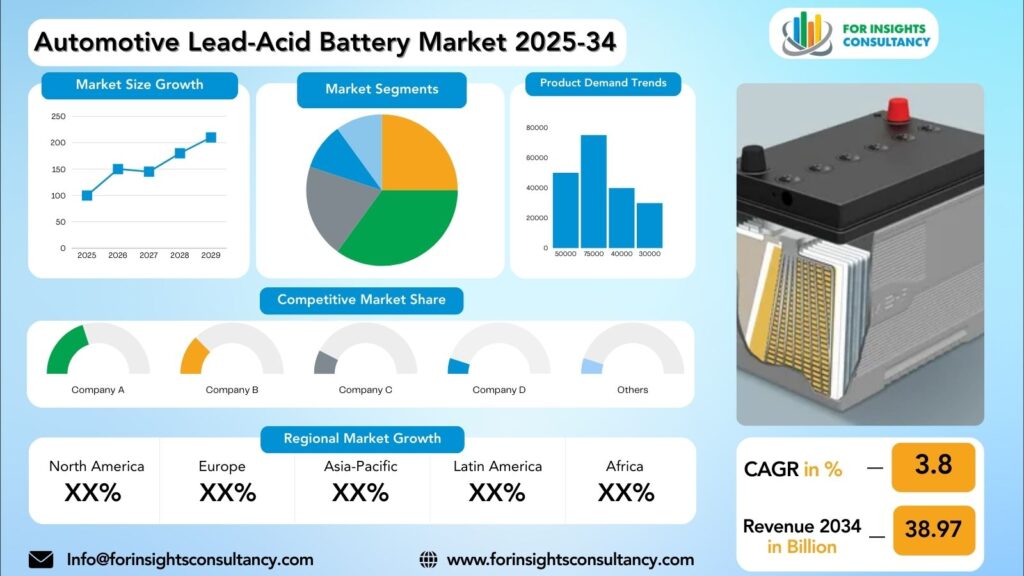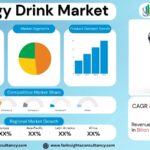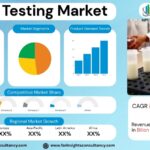
Automotive Lead-Acid Battery Market Research Report by Vehicle Type (Commercial Vehicles, Passenger Vehicles, Two-Wheelers and Three-Wheelers), by Product Type (Micro-Hybrid Batteries, SLI (Starting, Lighting, and Ignition) Batteries), by Technology/Construction, by Sales Channel And Region Global Market Analysis and Forecast, 2025-2034
Aug-2025 Formats | PDF | Category: Automotive | Delivery: 24 to 72 Hours
Automotive Lead-Acid Battery Market is forecast to increase from USD 29.56 billion in 2025 to USD 38.97 billion by 2034, at a CAGR of 3.8%.
Automotive Lead-Acid Battery Market: A Comprehensive Overview and Future Developments
The automotive lead-acid battery market is a crucial component of the automotive industry, providing energy for various vehicles, including traditional gasoline cars and electric vehicles. These batteries are known for their durability and reliability, making them popular choices for manufacturers and consumers. To meet the growing demand for electric vehicles, manufacturers are investing in research and development to improve their performance and efficiency.
One key focus is enhancing the energy density of lead-acid batteries, allowing them to store more energy and provide longer driving ranges. Advancements in battery technology are also leading to the development of new types of lead-acid batteries, such as absorbent glass mat (AGM) batteries and enhanced flooded batteries. These new designs offer improved performance and reliability compared to traditional flooded lead-acid batteries, making them attractive options for both automotive manufacturers and consumers.
Automotive Lead-Acid Battery Market Dynamics
Growth Drivers
The lead-acid battery market is experiencing growth due to the increasing adoption of electric vehicles (EVs), the growing automotive aftermarket, and the expansion of solar energy systems. EVs provide cost-effective and reliable energy storage solutions, and governments worldwide are incentivizing their adoption. automotive Lead-acid batteries are also popular for their affordability and durability, making them a popular choice for replacement. The demand for solar batteries is also growing, making lead-acid batteries an ideal choice for storing solar energy. Technological advancements in lead-acid battery technology have made them more efficient and reliable, making them an attractive option for various applications. The automotive lead-acid battery market is also experiencing significant growth in emerging markets, where the demand for affordable and reliable energy storage solutions is high. Countries in Asia, Latin America, and Africa are experiencing rapid industrialization and urbanization, leading to the need for reliable transportation and energy systems. Lead-acid batteries are well-suited to meet these needs, further fueling the market’s growth.
Restraints
The Automotive Lead-Acid Battery Market faces several challenges, including market saturation, environmental concerns, technological advancements, and cost considerations. The market is highly competitive, leading to price wars and decreased profit margins for companies. Environmental concerns are growing due to the toxic nature of lead, a key component of lead-acid batteries. The push towards sustainable and eco-friendly options is putting pressure on companies that rely on lead-acid batteries. Technological advancements, such as lithium-ion batteries, are also driving the demand for more efficient and longer-lasting battery options, which is a threat to the traditional lead-acid battery market. Cost considerations are another challenge, as manufacturers face rising raw material costs and stricter environmental regulations, making it increasingly difficult to maintain cost-effective production practices. Overall, the Automotive Lead-Acid Battery Market faces several challenges to overcome.
Opportunity
Lead-acid batteries are a crucial component in automotive applications due to their cost-effectiveness, reliability, and ability to deliver high surge currents. They are easy to manufacture and recycle, making them a sustainable choice for car manufacturers. Lead-acid batteries are also versatile, suitable for use in extreme cold and hot weather conditions. As the automotive industry shifts towards electric and hybrid vehicles, the demand for energy-efficient solutions is increasing. Lead-acid batteries are increasingly used in these vehicles for auxiliary functions and backup systems. Emerging trends in the automotive lead-acid battery market include the development of enhanced lead-acid battery technologies like absorbent glass mat (AGM) and valve-regulated lead-acid (VRLA) batteries, which offer improved performance, longer lifespan, and better reliability. Additionally, the increasing adoption of start-stop technology in vehicles is driving the growth of the automotive lead-acid battery market. This technology automatically shuts off the engine when the vehicle is stationary, reducing fuel consumption and emissions. Lead-acid batteries play a vital role in powering start-stop systems, providing the necessary energy to restart the engine quickly and efficiently.
Challenges
The automotive lead-acid battery market is facing several challenges due to the increasing demand for electric vehicles and renewable energy storage solutions. The market is grappling with the need for sustainable alternatives, limited energy density, and environmental concerns. Traditional lead-acid batteries are being scrutinized for their impact on the environment, making them less appealing to consumers. Proper disposal and recycling of lead-acid batteries are crucial to prevent contamination of groundwater and soil. Despite being more affordable than lithium-ion batteries, lead-acid batteries still face challenges in cost competitiveness. Manufacturers are investing in research and development to improve performance and durability, implementing innovations like advanced sealing technologies, enhanced materials, and improved manufacturing processes. Stakeholders are also focusing on sustainable practices like battery recycling and closed-loop systems to minimize the environmental impact of lead-acid batteries. Initiatives to streamline recycling and disposal processes and develop greener battery technologies are underway. Collaboration between industry players, government agencies, and environmental organizations is driving the adoption of sustainable practices and regulatory frameworks. Partnerships and alliances are being formed to facilitate the transition towards cleaner and more efficient energy storage solutions in the automotive sector.
Automotive Lead-Acid Battery Market Top Companies Covered In This Report:
Evaluate The Strategic Positioning And Innovation Pipelines Of Leading Market Companies-From Multinational Enterprises To Disruptive Regional Firms. Understand How Key Players Are Innovating, Expanding, And Capturing Value, And Use Competitive Benchmarks To Plan Your Next Move.
- Tianneng Rechargeable Battery Manufacturers (China)
- Reem Batteries (Oman)
- Century Batteries Indonesia (Indonesia)
- Leoch International Technology Limited Inc (Singapore)
- Robert Bosch LLC (US)
- Stryten Energy (US)
- Exide Technologies (France)
- Clarios (US)
- EnerSys (US)
- East Penn Manufacturing Company (US)
- GS Yuasa International Ltd. (Japan)
- Exide Industries Ltd. (India)
- C&D Technologies, Inc. (US)
- Camel Group Co., Ltd. (China)
- Amara Raja Energy & Mobilty Limited (India)
- The Furukawa Battery Co., Ltd. (Japan)
- Crown Battery (US)
- Fiamm Energy Technology S.p.A. (Italy)
- CSB Energy Technology Co., Ltd. (Taiwan)
- Moura Accumulators SA (Brazil)
Automotive Lead-Acid Battery Market News
Exide Industries Ltd. (India): A key player in the Indian market, Exide focused on both its traditional lead-acid battery business and its new ventures into lithium-ion batteries. In early 2024, Exide announced plans to introduce premium AGM lead-acid batteries for fossil-fuel vehicles in India to meet the demand for enhanced performance and durability from major OEMs. The company also reported strong financial results in its automotive and industrial battery segments.
Clarios’ $6 Billion Investment Plan: In a major move, Clarios announced a $6 billion investment over the next 10 years to expand its U.S. manufacturing facilities, strengthen its critical minerals supply chain, and develop next-generation technologies. This plan highlights the company’s long-term commitment to the lead-acid battery market and its strategic focus on domestic production and recycling. The investment will also support the development of advanced batteries and supercapacitor systems for new applications, including data centers and AI.
Exide Industries’ Financial Performance: Exide Industries reported strong first-quarter results for the 2025-2026 fiscal year, with a significant rise in consolidated net profit. The company’s managing director noted double-digit growth in its automotive replacement and industrial segments. The company also continued to invest in its new lithium-ion cell manufacturing facility, showcasing a dual-pronged strategy to address both legacy and future battery markets.
GS Yuasa’s Product Launches: GS Yuasa launched new products to cater to the evolving market. In May 2025, the company announced a renewed “ECO.R Revolution Series” for both idling stop and general vehicles, demonstrating its commitment to enhancing its product line to meet the needs of modern vehicles. The company also reported strong earnings, driven by its automotive battery business.
Segmented View of the Industry:
The Automotive Lead-Acid Battery Market Is Mapped Through A Multidimensional Lens-Tracking Shifts Across Product Type, Applications, And Geographic Regions. This Segmented Approach Enables Businesses To Localize Their Growth Plans And Align Offerings With The Most Profitable Demand Centers.
Segmentation by Product Type
- SLI (Starting, Lighting, and Ignition) Batteries
- Micro-Hybrid Batteries
Segmentation by Vehicle Type
- Commercial Vehicles
- Two-Wheelers
- Two-Wheelers and Three-Wheelers
Segmentation by Technology/Construction
- Valve Regulated Lead-Acid (VRLA) Batteries
- Flooded Lead-Acid Batteries
Segmentation by Sales Channel
- Aftermarket
- OEM (Original Equipment Manufacturer)
Global Geographic Coverage:
The Report Provides In-Depth Qualitative and Quantitative Data On the Automotive Lead-Acid Battery Market For All Of The Regions And Countries Listed Below:
North America
North America’s automotive lead-acid battery market is dominated by the United States, Canada, and Mexico. The US, with its strong automotive industry and high vehicle demand, is a major player in this market. The rise of electric vehicles and hybrid cars has boosted demand for advanced lead-acid batteries with improved performance and longer lifespans. Canada, with its focus on sustainable transportation and commitment to reducing carbon emissions, is also a significant market. Manufacturers in Canada are investing in research and development to create innovative battery solutions. Mexico, with its growing automotive industry and export-oriented manufacturing sector, is emerging as a significant player in the market. The country’s proximity to the US and favorable trade agreements make it an attractive location for battery manufacturers to expand their presence. The market for lead-acid batteries is expected to witness substantial growth in the coming years.
Europe
The automotive lead-acid battery market in Europe is thriving due to the increasing adoption of electric vehicles and stringent environmental regulations. Germany, France, and the UK are leading the way in this market. Germany, with its numerous automakers and support for green initiatives, is a significant player in the market. France, on the other hand, has been proactive in promoting sustainable transportation solutions, leading to a rise in electric vehicle adoption. The UK has also seen a surge in demand for lead-acid batteries due to the increasing number of electric vehicles on the road and the government’s commitment to phasing out internal combustion engine vehicles.
Asia Pacific
The automotive lead-acid battery market in the Asia Pacific region is dominated by China, India, Japan, and Australia. China’s large automotive manufacturing sector and focus on electric vehicles and renewable energy sources have boosted demand for lead-acid batteries. India’s booming automotive industry and increasing adoption of electric vehicles have led to a surge in demand for lead-acid batteries. The government’s initiatives to promote sustainable mobility solutions have also boosted demand.
Japan, a pioneer in automotive technology, has been at the forefront of developing advanced lead-acid batteries for electric vehicles. With a strong focus on innovation and sustainability, Japanese manufacturers are producing high-quality batteries for automotive applications. The demand for lead-acid batteries in Japan is expected to remain robust. Australia, with its vast landscape and remote areas, is also a key market for lead-acid batteries. As Australia transitions towards a greener future, the demand for lead-acid batteries is set to rise, presenting lucrative opportunities for market players.
Middle East and Africa
The Middle East is experiencing a surge in automotive manufacturing and sales, boosting the demand for lead-acid batteries. Countries like Saudi Arabia, UAE, and Iran are leading the way in the automotive industry, boosting the market for lead-acid batteries. The increasing adoption of electric vehicles in the region is expected to further increase the demand for lead-acid batteries.
Africa, with its diverse automotive landscape, presents unique opportunities and challenges for the lead-acid battery market. Key players in Africa include South Africa, Nigeria, and Egypt, which are contributing significantly to the demand for lead-acid batteries due to urbanization and infrastructure development. Saudi Arabia’s focus on reducing carbon emissions and promoting sustainable transportation solutions is driving an increased adoption of electric vehicles, boosting the demand for lead-acid batteries. The UAE, with its strong emphasis on innovation and technology, is also witnessing a growing interest in electric vehicles, driving the demand for lead-acid batteries as a reliable energy storage solution. South Africa, with its automotive industry fueled by domestic production and imports, also has a robust demand for lead-acid batteries in vehicles of all types.
Reasons to Buy:
- The Research Would Help Top Administration/Policymakers/Professionals/Product Advancements/Sales Managers And Stakeholders In This Market In The Following Ways.
- The Report Provides Automotive Lead-Acid Battery Market Revenues At The Worldwide, Regional, And Country Levels With A Complete Analysis To 2034 Permitting Companies To Analyze Their Market Share And Analyze Projections, And Find New Markets To Aim For.
- To Understand The Most Affecting Driving And Restraining Forces In The Market And Their Impact On The Global Market.
- Major Changes And Assessment In Market Dynamics And Developments.
- The Objective Of The Automotive Lead-Acid Battery Market Report Is To Identify New Business Opportunities Using Quantitative Market Forecasts.
- Formulate Sales And Marketing Strategies By Gaining An Understanding Of Competitors, Their Positioning, And Strengths & Weaknesses.
Faq – What Global Leaders Are Asking
What Is The Growth Prospect For The Automotive Lead-Acid Battery Market By 2034?
Automotive Lead-Acid Battery Market Is Expected To Achieve A Stable Growth Rate With A Compound Annual Growth Rate (Cagr) Of About 3.8% From 2025 Through 2034.
What Is Driving The Growth Of The Automotive Lead-Acid Battery Market?
The automotive lead-acid battery market is expected to show steady growth by 2034, driven by the enduring demand from the vast fleet of internal combustion engine vehicles and a strong replacement market. While facing competition from lithium-ion, its cost-effectiveness and high recyclability will ensure its continued relevance, particularly in the aftermarket and in vehicles with start-stop systems.
Who Are The Key Players In The Automotive Lead-Acid Battery Market, And What Are Their Market Shares?
The Automotive Lead-Acid Battery Market Includes Major Companies Like Tianneng Rechargeable Battery Manufacturers (China), Reem Batteries (Oman), Century Batteries Indonesia (Indonesia), Leoch International Technology Limited Inc (Singapore), Robert Bosch LLC (US), Stryten Energy (US), Exide Technologies (France), Clarios (US), EnerSys (US), East Penn Manufacturing Company (US), GS Yuasa International Ltd. (Japan), Exide Industries Ltd. (India).
Specific Market Share Data Is Not Publicly Available And Is Typically Provided In Detailed, Proprietary Market Research Reports.
Which Regions Are Leading The Automotive Lead-Acid Battery Market Growth?
The Asia-Pacific region is the clear leader in the automotive lead-acid battery market, driven by its massive automotive industry and high demand from populous countries like China and India. North America and Europe also hold significant shares, supported by their large vehicle fleets and a robust aftermarket for replacement batteries.
Customization: We Can Provide Following Things
1) On Market More Company Profiles (Competitors)
2) Data About Particular Country Or Region
3) We Will Incorporate The Same With No Additional Cost (Post Conducting Feasibility).
Any Requirement Contact Us: Https://Www.Forinsightsconsultancy.Com/Contact-Us/
Table of Contents
For TOC Contact us: https://forinsightsconsultancy.com/contact-us/






